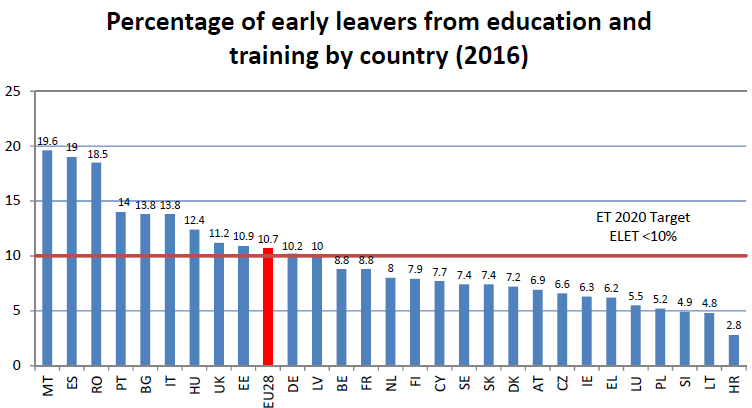Data on early school leaving and rates of young people not in employment education or training illustrate the difficulties young people face in today’s world, as well as the economic and social consequences of their being cut off from the labour market and education. They also underline the importance of keeping young people in education and training.
Between 2008 and 2013, the proportion of young people aged 18 to 24 not in employment, education or training (NEETs) in Europe increased from 14% to 17% due to the economic downturn. The rate of NEETs aged 18 to 24 varies widely across Europe. Italy (29.3%), Greece (28.6%) and Cyprus (27.1%) have the highest rates and an upwards trend, while the Netherlands (6.7%) and Luxembourg (6.7%) have the lowest levels.
Young people who leave school early with only low levels of education are more likely to be NEETs. In 2013, across the EU, nearly 5.5 million young people between 18 and 24 years old had not finished upper secondary education and were not in formal or non-formal education and training and not working. Even if they are working, younger people with only lower-secondary education are more likely to be in insecure and low-paid jobs.
And their job prospects are expected to get worse. Cedefop’s latest skill forecasts show that in the EU in 2005 almost a quarter of jobs were filled by people with only lower secondary education, by 2025 this will fall to around 16%.
Growing demands for high skills and qualifications mean that upper secondary education is increasingly regarded as the minimum attainment level for young people in Europe. Young people leaving education and training prematurely lack crucial skills. They run the risk of having serious and persistent problems in finding and keeping a job. Young people not in employment, education or training are at higher risk of social exclusion. They have a lower level of interest and engagement in politics and lower levels of trust.
Working to reduce early school leaving
The Europe 2020 Strategy is to bring down early school leaving to below 10% by 2020. In 2013, the figure was 11.9%, compare to 12.7% in 2012. The situation varies considerably across Member States (see Figure). Some 10 Member States have reached the 10% benchmark. Spain (23.5%), Malta (20.9%), and Portugal (19.2%) have the highest rates of early school leavers, but despite these high rates have made considerable progress in recent years.
Figure: Early school leaving rate (2013)

Source: Eurostat (Code: t2020_40)
Other Member States that have reduced their early school leaving rates in 2013 compared to 2012 include Cyprus (now 9.1%), Latvia (9.8%) and Bulgaria (12.5%). Only in Hungary, the Netherlands, Slovakia and Finland have rates gone up over the last year.
On average, each generation has fewer young people leaving school early when compared to the previous one. However, there is a striking disparity between males and females. Boys are more likely to leave school before finishing upper secondary education than girls. The gender difference has slowly reduced from 3.8 percentage points in 2009 to 3.4 percentage points in 2013, but it is still sizeable in all Member States except Bulgaria, the Czech Republic and Slovakia. The difference is greatest in Cyprus, Latvia and Poland, where boys are more than twice as likely to leave school early then girls.
The role of VET in tackling early school leaving
Between 2009 and 2012 there has been a significant fall in early school leaving rates; whether this is due to policies to keep students in education longer, or the economic downturn is up for debate. However, significant efforts have and are being made been made to assess, understand and address the problem of early school leaving in EU countries in the recent years.
Cedefop data show that among policies adopted across Europe to tackle early school leaving, a focus is put on improving vocational education and training (VET) systems. This includes improving vocational guidance systems (Latvia, Lithuania); easing the transition to the labour market (Finland, the Netherlands); and making it easier to move between general and vocational education (Malta, Poland). Portugal and Spain have increased access to VET especially for students struggling in general education.

